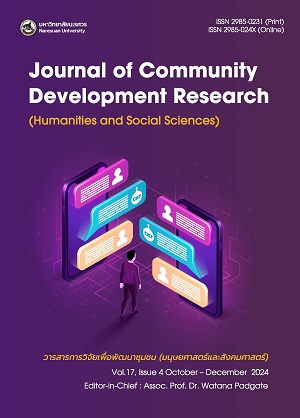Confirmatory Factors Analysis of the Learning Ecosystem Towards Desired Outcomes of Learners
##plugins.themes.bootstrap3.article.main##
Abstract
This research aims to analyze the confirmatory components and verify the congruence of the model indicators of learning ecosystem towards desired outcomes of learners in basic education. The sample group consists of 500 individuals, including school administrators and teachers attached to the Basic Education Office, selected through stratified random sampling based on school sizes and geographical regions. The research tool is a questionnaire assessing factors influencing the desired outcomes of learners at the basic education level, employing a 5-point Likert scale. The validity of the questionnaire was confirmed through content validation by five experts in educational administration and measurement, yielding an index of congruence ranging from 0.80 to 1.00. The reliability coefficient using Cronbach’s alpha was 0.969.
The results of the Confirmatory Factor Analysis (CFA) using Mplus program revealed two key findings: 1) The components of the learning ecosystem consist of 5 factors with their respective standardized factor loadings: Learning Culture (β = 0.989) emerged as the strongest factor, followed by Stakeholder Support (β = 0.951), Learning Resources (β = 0.863), Content (β = 0.805), and Educational Policy (β = 0.709), 2) The confirmatory factor analysis demonstrated that the model fits well with the empirical data, validating the theoretical framework of learning ecosystem components in basic education context. These findings suggest that learning culture and stakeholder support are crucial elements in developing an effective learning ecosystem for achieving desired learner outcomes in basic education.
Keywords: Learning Ecosystem, Desired Outcomes of Learners, Confirmatory Factor Analysis, Basic Education
References
Byrne, B. M. (2010). Structural Equation Modeling with Amos: Basic Concepts, Applications, and Programming (2nd ed.). New York: Taylor and Francis Group.
EdTech Center World Education. (n.d.). What is a Learning Ecosystem? Retrieved from https://edtech.worlded.org/what-is-a-learning-ecosystem/
George, D., & Mallery, M. (2010). SPSS for Windows Step by Step: A Simple Guide and Reference, 17.0 Update (10th ed.). Boston: Pearson.
Hu, L., & Bentler, P. M. (1999). Cutoff Criteria for Fit Indexes in Covariance Structure Analysis: Conventional Criteria Versus New Alternatives. Structural Equation Modeling: A Multidisciplinary Journal, 6(1), 1–55. https://doi.org/10.1080/10705519909540118
Jankham, P. (2023). Development of Learning Ecosystem to Promote Vocational Skills of Rajaprajanukroh School 22 in Mae Hong Son Province. Journal of Educational Management and Research Innovation, 5(4), 885-896. Retrieved from https://so02.tci-thaijo.org/index.php/jemri/article/view/262108
Junphengphen, K., Cheyban, P., & Sroinam, S. (2023). Effect of School Administrator’s Leadership on Quality of Small-sized Schools: An Analysis of Structural Equation Model with Multiple Mediators. Journal of Education Studies, 51(4), EDUCU5104008. https://doi.org/10.14456/educu.2023.35
Khacha, R., & Thawinkarn, D. (2023). A Model for Development of Digital Learning Culture in Primary Schools Under Chaiyaphum Primary Education Service Area Office 3. Journal of Educational Measurement, Mahasarakham University, 29(1), 161-175. Retrieved from https://so02.tci-thaijo.org/index.php/jemmsu/article/view/256005
Khongcharoen, P., Kaewurai, W., & Boonphuak P. (2023). The Effects of Using Learning Activities Based on Design Thinking Process with Family and Community Engagement to Enhance Learning and Innovation Skills for Grade 11 Students. Journal of Education Studies, 51(3), EDUCU5103009. https://doi.org/10.14456/educu.2023.27
Kline, R. B. (2015). Principles and Practice of Structural Equation Modeling (4th ed.). New York: Guilford Press.
Kongmanus, K. (2018). Digital Learning Tools: Way of Digital Education Era. Journal of Education and Innovation, 20(4), 279-290. Retrieved from https://so06.tci-thaijo.org/index.php/edujournal_nu/article/view/122056
Maneehaet, S., & Wannapiroon, P. (2019). A Digital Learning Ecosystem with Artificial Intelligence for Smart Learning. Journal of Education and Innovation, 21(2), 359-373. Retrieved from https://so06.tci-thaijo.org/index.php/edujournal_nu/article/view/159123
Megatrends Watch Institute. (n.d.). Global Megatrends 2050. Retrieved from http://www.megatrends2050.com
Nunnally, J. C., & Bernstein, I. H. (1967). Psychometric Theory (Vol. 226). New York, NY: McGraw-Hill.
OECD. (2018). The Future of Education and Skills Education 2030. Retrieved from https://repository.canterbury.ac.uk/download/96f6c3f39ae6dcffa26e72cefe47684172da0c93db0a63d78668406e4f478ae8/3102592/E2030%20Position%20Paper%20%2805.04.2018%29.pdf
Office of the Education Council. (2019). National Education Standards B.E. 2561 (2018). Bangkok: 21 Century.
Office of the Education Council. (2021). Proposal for a Learning System that Responds to Future World Changes in 2040. Bangkok: Eleven Star Intertrade. Retrieved from https://www.onec.go.th/th.php/book/BookView/1852
Office of the Education Council, Ministry of Education. (2021). Report on the Study of the Appropriateness of Learning Environment Arrangements in the Context of Thailand. Samutprakan: SBK Printing. Retrieved from https://www.onec.go.th/th.php/book/BookView/1886
Office of the Education Council, Ministry of Education. (2022). Study Report on the Learning Environment System Format that Supports the Development of Thai 4.0 Capabilities. Retrieved from https://fliphtml5.com/wbpvz/pbyl/basic
Phueadkhlai, C. (2022). Book Review: Development of Competency-based Curriculum and Meaningful Learning Management. Journal of Information and Learning, 33(3), 128-135. Retrieved from https://so04.tci-thaijo.org/index.php/jil/article/view/258220
Planning Division, Chiang Mai University. (2021). Chiang Mai University’s Education Development Plan for Phase 13 (2023-2027). Retrieved from https://planning.oou.cmu.ac.th/?p=3570
Rattanakhamfu, S. (2022, April 11). The Learning Ecosystem in Response to Changes in the World of Work and the Emergence of New Skills [Video File]. Retrieved from https://www.youtube.com/watch?v=HMo0sFWXn9A
School of Lifelong Education, Chiang Mai University. (n.d.). About Us: CMU Lifelong. Retrieved from https://www.lifelong.cmu.ac.th/about
Spencer-Keyse, J., Luksha, P., & Cubista, J. (2020). Learning Ecosystems: An Emerging Praxis for the Future of Education. The Netherlands: Moscow School of Management SKOLKOVO & Global Education Futures. Retrieved from https://inee.org/resources/learning-ecosystems-emerging-praxis-future-education
Theodotou, M. (2020, December 14). Learning Ecosystem: Why You Need One, How to Build It. ATD. Retrieved from https://www.td.org/insights/learning-ecosystem-why-you-need-one-now-and-how-to-build-it
Wichitaksorn, N., & Amarase, N. (2023). A Portrait of High-income Thailand: Future Labor Market Outlook [PowerPoint Slides]. Retrieved from https://tdri.or.th/wp-content/uploads/2023/01/HIT_Labor_NW.pdf
